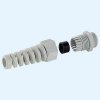It is common practice in the marine electronics world to tie all electronics accessories (lights, sonar, pump ect. ) to a common ground wire. That common ground then goes to the negative post of a marine battery. My question is, How do I splice the negative lead of accessories to a common ground wire? That would be like connecting three wires together. To further complicate things its common to avoid soldering because of the excessive vibration of the marine world. How should I connect accessories to a common ground?
My boat looks like this
**broken link removed**
Thanks for the help
My boat looks like this
**broken link removed**
Thanks for the help

